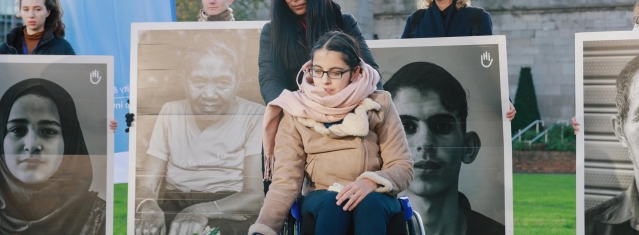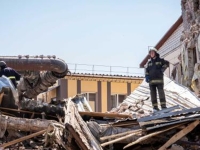News
Over 80 Countries Committed to Curb Use of Explosive Weapons
ReliefWeb Press Release

Nujeen Mustafa, disability/refugee rights activist (Source: © 2022 International Network on Explosive Weapons)
ARAC Int Strategic Communications -
News and Press Release
Format Source:HRW | Posted:3 Dec 2022 | Originally published:28 Nov 2022
Nujeen Mustafa in the cover photo, a Syrian disability and refugee rights activist who fled bombing in Aleppo, placed flowers on a Memorial to the Unknown Civilian before the endorsement of the new political declaration on the use of explosive weapons in populated areas in Dublin, Ireland, on Nov. 18, 2022. © 2022 International Network on Explosive Weapons.
“Over 80 Countries Committed to Curb Use of Explosive Weapons, Now Comes the Hard Part” by Bonnie Docherty was originally published on Just Security.
Last week, more than 80 countries endorsed a new international commitment to address one of the greatest threats to civilians during armed conflict: the use of explosive weapons in populated areas. Explosive weapons include aircraft bombs, artillery, rockets, and missiles, and their use in cities, towns, and villages causes thousands of civilian casualties around the world each year.
Format Source:HRW | Posted:3 Dec 2022 | Originally published:28 Nov 2022
Nujeen Mustafa in the cover photo, a Syrian disability and refugee rights activist who fled bombing in Aleppo, placed flowers on a Memorial to the Unknown Civilian before the endorsement of the new political declaration on the use of explosive weapons in populated areas in Dublin, Ireland, on Nov. 18, 2022. © 2022 International Network on Explosive Weapons.
“Over 80 Countries Committed to Curb Use of Explosive Weapons, Now Comes the Hard Part” by Bonnie Docherty was originally published on Just Security.
Last week, more than 80 countries endorsed a new international commitment to address one of the greatest threats to civilians during armed conflict: the use of explosive weapons in populated areas. Explosive weapons include aircraft bombs, artillery, rockets, and missiles, and their use in cities, towns, and villages causes thousands of civilian casualties around the world each year.
The political declaration, which 82 countries signed at a ceremony in Dublin Castle on Nov. 18, goes beyond calling for better compliance with existing international humanitarian law by committing the endorsing countries to take additional measures to prevent and remediate the devastating humanitarian consequences of the use of explosive weapons in populated areas.
The success of the endorsement conference warrants celebration, but it also marks the beginning of a new phase of work. Governments, international organizations, and civil society groups now need to focus on universalizing, interpreting, and implementing the document.
The success of the endorsement conference warrants celebration, but it also marks the beginning of a new phase of work. Governments, international organizations, and civil society groups now need to focus on universalizing, interpreting, and implementing the document.
A New Political Declaration to Protect Civilians
While not legally binding, the declaration is a milestone for efforts to advance humanitarian disarmament and curb human suffering during armed conflict. It sets international standards for restricting the use of explosive weapons. It demands military training and changes in national policies and practices that have the potential to reduce the harm from a method of war that causes direct and indirect, or reverberating, effects. It also includes commitments on victim assistance, data collection and sharing, and follow-up meetings.The declaration is the product of a three-year process led by Ireland. Its signatories come from every region of the world and include countries affected by armed conflict and major military powers. Six of the world’s top eight arms exporters — the United States, France, Germany, Italy, the United Kingdom, and South Korea — have joined, as well as 24 of 30 NATO Member States.
Ukraine expressed its support at the conference for the declaration’s spirit and principles, but said that it would only be able to endorse the instrument after its conflict with Russia ended and it regained sovereignty over its territory.
The Cost of Explosive Weapons
The use of explosive weapons in populated areas has high costs for civilians both at the time of attack and long after. The weapons’ blast and fragmentation cause widespread civilian casualties and inflict psychological trauma. According to Action on Armed Violence, when explosive weapons are used in populated areas, an average of 90 percent of those killed or injured are civilians.Damage to or destruction of civilian infrastructure, including power, water, and sanitation facilities, interferes with basic services, such as health care and education, even long after the conflict ends. The lack of services in turn infringes on human rights, such as the right to education or to quality, available, and accessible health care.
The use of explosive weapons also causes harm to the environment. Bombing and shelling of industrial facilities, for example, releases toxins into the air or water sources. Explosive ordnance lingers long after conflict. The threat of immediate death and injury as well as the reverberating effects discussed above drive mass displacement.
All of these consequences are exacerbated when the explosive weapons have wide area effects, that is, when their impacts cover a broad footprint. Explosive weapons have such effects if they have a wide blast or fragmentation radius, are inaccurate, or deliver multiple munitions at once. The political declaration recognizes these factors as increasing the risk of “a devastating impact on civilians and civilian objects” (paragraph 1.2).
Human Rights Watch and other groups have documented the direct and indirect effects of explosive weapons in recent armed conflicts, including in Afghanistan, Armenia, Azerbaijan, Gaza, Iraq, Libya, Somalia, Sri Lanka, Syria, Ukraine, and Yemen.
Human Rights Watch and other groups have documented the direct and indirect effects of explosive weapons in recent armed conflicts, including in Afghanistan, Armenia, Azerbaijan, Gaza, Iraq, Libya, Somalia, Sri Lanka, Syria, Ukraine, and Yemen.
A New Challenge Ahead: Implementing the Declaration
As countries translate the declaration’s words into actions, they should stay true to the declaration’s goal of strengthening civilian protection. Safeguarding Civilians, a recent report co-published by Human Rights Watch and the Harvard Law School International Human Rights Clinic, for which I work, examines several of the declaration’s key commitments and interprets them through a humanitarian lens. Some of its findings are presented below.The core, and most debated, provision of the declaration calls on countries to adopt “policies and practices to help avoid civilian harm, including by restricting or refraining as appropriate from the use of explosive weapons in populated areas, when their use may be expected to cause harm to civilians or civilian objects” (paragraph 3.3). We, and others, argue it is “appropriate” for countries to “refrain from” the use of explosive weapons with wide area effects in populated areas, given that the harm of such weapons can always be expected. Countries should then “restrict” the use of all other explosive weapons in populated areas.
In addition, under paragraph 3.4, countries should take into account the direct and indirect effects of the use of explosive weapons in populated areas when planning and executing attacks because these effects meet the declaration’s threshold of being reasonably foreseeable.
Remediating the humanitarian consequences of the use of explosive weapons demands comprehensive victim assistance measures, another key element of the declaration (paragraph 4.5). Assistance should be provided to affected individuals, families, and communities and take a variety of forms. It should be integrated, inclusive, and gender sensitive.
Data collection and sharing are essential to both preventing and remediating the harm caused by the use of explosive weapons in populated areas. An accurate and in-depth understanding of effects can inform lessons learned, help identify the kinds of victim assistance needed, facilitate international cooperation and assistance, and promote monitoring and compliance.
Remediating the humanitarian consequences of the use of explosive weapons demands comprehensive victim assistance measures, another key element of the declaration (paragraph 4.5). Assistance should be provided to affected individuals, families, and communities and take a variety of forms. It should be integrated, inclusive, and gender sensitive.
Data collection and sharing are essential to both preventing and remediating the harm caused by the use of explosive weapons in populated areas. An accurate and in-depth understanding of effects can inform lessons learned, help identify the kinds of victim assistance needed, facilitate international cooperation and assistance, and promote monitoring and compliance.
Countries should make clear that they will collect and share operational data about weapons and targets as well as information about the range of effects of explosive weapons. Both are necessary to achieve the declaration’s goals. While the declaration says data should be collected and shared “where feasible and appropriate” (paragraph 4.2), rather than use that caveat as an excuse to avoid transparency, countries should work to ensure that data collection and sharing are feasible and presume they are appropriate unless they risk further harm.
Finally, countries should live up to their commitment to engage in follow-up work on the declaration, including through regular meetings (paragraph 4.7). Those meetings are essential opportunities to exchange views on policies, practices, and interpretations of the declaration, provide updates on progress, share collected data, and promote implementation. Maintaining the inclusiveness that has characterized this process to date will add value to the discussions.
Finally, countries should live up to their commitment to engage in follow-up work on the declaration, including through regular meetings (paragraph 4.7). Those meetings are essential opportunities to exchange views on policies, practices, and interpretations of the declaration, provide updates on progress, share collected data, and promote implementation. Maintaining the inclusiveness that has characterized this process to date will add value to the discussions.
At the Dublin conference, Norway announced that it will host the declaration’s next meeting in 2024. That date may seem far way, but the declaration’s first major test will be how much can be accomplished by then to carry out its provisions. While addressing the humanitarian consequences of the use of explosive weapons in populated areas is a challenging process, countries that signed the declaration should strive to realize their commitments effectively and efficiently with that date — and especially civilian lives — in mind.
Disclaimer
Human Rights Watch
© Copyright, Human Rights Watch - 350 Fifth Avenue, 34th Floor New York, NY 10118-3299 USA
Source: ReliefWeb
ARAC International is a member of UN OCHA Humanitarian Response
____________________________________________________________
Office of Strategic Communications & Analysis
ARAC International, Global Security Analyst | Human Rights Consultant
Certified by the U.S. Institute for Diplomacy and Human Rights
Institute for Economics and Peace Ambassador
https:/iep.arac-international.org
Disclaimer
Human Rights Watch
© Copyright, Human Rights Watch - 350 Fifth Avenue, 34th Floor New York, NY 10118-3299 USA
Source: ReliefWeb
ARAC International is a member of UN OCHA Humanitarian Response
____________________________________________________________
Office of Strategic Communications & Analysis
ARAC International, Global Security Analyst | Human Rights Consultant
Certified by the U.S. Institute for Diplomacy and Human Rights
Institute for Economics and Peace Ambassador
https:/iep.arac-international.org
more information: https://www.arac-international.org/2022/12/over-80-countries-committed-to-curb-use.html
Liability for this article lies with the author, who also holds the copyright. Editorial content from USPA may be quoted on other websites as long as the quote comprises no more than 5% of the entire text, is marked as such and the source is named (via hyperlink).






